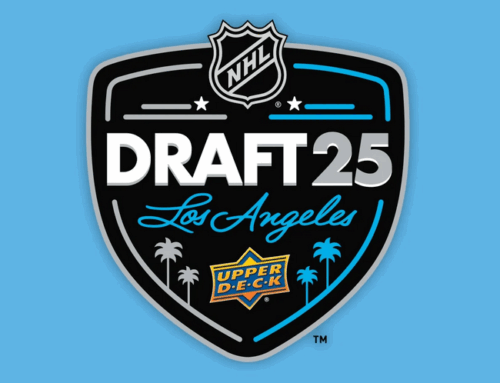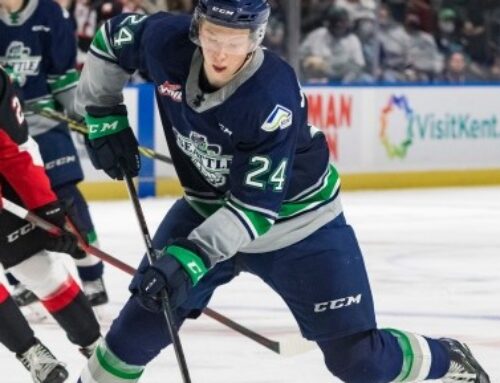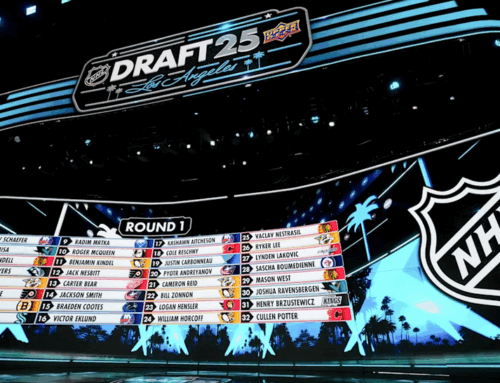Prospect Ramblings: Goaltenders and Height Biases in NHL Drafting
Hadi Kalakeche
2022-01-11
Welcome to my ramblings, where I’ll be writing down my thoughts on NHL and draft-eligible prospects once a week. I’ll be using the ramblings to keep you posted on the week’s events, or let you in on some questions I ask myself often regarding prospects, amateur scouting and player development.
This week, I had a question on my mind that just wouldn’t let go, to the point that I needed to sit down and write about it.
Does size matter?
I mean for goalies, of course. 5-foot-11 netminder Juuse Saros’ performances so far this season for Nashville (2.21 GAA, .929 sv%) have caused me to wonder about the fact that sub-6-foot goaltenders very rarely get selected in higher rounds at the NHL draft, and how opportunities to draft prospects with promising tools and impressive numbers have been missed by many teams due to size biases, often in favor of picking a tall player and chiseling away at him until an NHLer appears.
Saros was a fourth-round pick, and the ninth goaltender selected back in 2013. Of the eight netminders picked before him, none have played more games than his 184 so far. Other than Tristan Jarry, none have been able to establish themselves as regular NHL netminders.
On the prospects’ side, the current NCAA leader in save percentage with a .958, 20-year-old Devon Levi, is 6 feet tall and was the 212th-overall pick of the Panthers in 2020. Dustin Wolf, a 5-foot-11, 160-pound netminder currently dominating the AHL, was the 214th pick of the Flames the year before.
Teams have been cited saying that they draft goaltenders for size first then work outwards from there, but is the baseline advantage of being taller really all that quintessential? I’ll be letting you in on my scouting philosophy when evaluating short goaltenders, and why they should be considered top-end prospects when they’ve learned the right things to compensate for their lack of size.
First Priority: Adaptive Skills — Reactiveness, Aggressiveness, Recovery Speed
For young goaltenders on the shorter side who feel boxed out of the NHL Draft due to something that’s outside of their control: use Juuse Saros as a blueprint. Watching him play, it’s abundantly clear that he’s adapted his game to his size, and without that, nothing works. A short goaltender who plays the exact style of a Carey Price or Ben Bishop will simply not stop pucks at a decent enough rate to make a significant, NHL-projectable difference. Both those goaltenders are fairly conservative in terms of their tendency to leave their paint and challenge shooters, relying on their sound reflexes and large coverage area to deflect pucks wide.
If you’re 5-foot-11, the first issue you’ll face is on high shots from the butterfly position. Lower shoulders means less of the top shelf being covered. The compensation required to adjust to NHL shooters is to 1) be conservative with butterfly usage and 2) be more aggressive on shooters, using your mobility as a shorter goalie to get to cross-ice passes when challenged shooters opt for it.
Case in point:
Juuse Saros has been playing some SERIOUSLY good hockey this season! pic.twitter.com/EkzJ5GKDJu
— NHL (@NHL) May 9, 2021
If we’re looking at prospects, Devon Levi’s profile is more or less the same. Explosive lateral movements, high-end focus in scramble situations, added mobility from the smaller frame and almost robotic positional play allow both goalies to get their chests square to pucks as often as a 6-foot-5 netminder can.
Levi also challenges shooters hard, especially off the rush when there isn’t a back-door option, but the key learning in his case will be choosing his moments to get aggressive. Sometimes, an opposing player will be fully set up at the back door and Levi will still challenge a point shot at the top of his circle.
At the end of the day, I see an underrated advantage in drafting shorter goalies; most of the time, their size makes them adapt in ways that can set them apart from larger goalies in terms of raw puck-stopping ability. Often, their quickness and reactiveness are honed over time, without even needing to specifically work on those elements in training. Just as a result of the conditions that come with being a short goaltender, they learn to deal with shots in a way that maximize those elements in their game.
This leads me to my second priority when scouting shorter goaltenders:
Raw Numbers — If You Can Stop Pucks, You Can Stop Pucks
The second most promising thing for a short netminder to have is a good stats line, especially in Juniors where shots are thrown at you in haywire fashion with little care and strategy involved. A short netminder’s ability to stop a barrage of haphazard shots from everywhere is much more impressive than their ability to read a cross-ice pass and get to it. For taller goaltenders, it’s the opposite — mobility and lateral explosiveness are often their lackings — but in the case of Dustin Wolf, for example, it is extremely promising to see him be as hermetic as he is in net.
Shorter netminders will tend to be a bit porous in junior hockey, but Wolf’s .935 save percentage in 149 games for the Everett Silvertips was a great sign of things to come, as plays just get more structured from there and Wolf deals with structure very well. As a result, the AHL’s run-and-gun, bumper-car style of hockey was an easy transition, with the netminder earning great numbers (19 GP, 16-1-2, 1.92 GAA, .936 sv%) so far with the Stockton Heat this year.
Dustin Wolf's sprawling save on Scott Reedy from earlier pic.twitter.com/F3Ivq4kKL1
— Skateboard B (@BDFwrites) January 2, 2022
This is the thing that gets me the most flack in the scouting sphere. Seemingly everyone says numbers are overrated when evaluating netminders, but they are one of the most consistently traceable indicators of skill, which — more often than not — compounds in results. You are more likely to find a good netminder in the draft by sorting for save percentage than you are to find one by sorting for size, or any other factor.
Not that size isn’t an asset; between two players with the same mobility, the same IQ, the same athleticism, the same everything, the taller one will likely stop more pucks, just from covering more surface area. But sometimes, you just have to look at their ability to stop pucks. That’s a better indicator of their NHL projectability than whether they can reach above the fridge or not.
What Our Goaltender Expert Thinks
To answer the question of whether size matters for goalies, I spoke to our goaltender scout, Danny Tiffany, to get his thoughts on the matter. I thought I’d leave you with his thoughts, as his opinion is one I value greatly when it comes to netminders, and is a great way to conclude this piece:
“I think size does matter, but there are instances where other attributes can be more beneficial from a scouting point of view. When you see a guy like Juuse Saros tearing up the NHL it shows that guys who have the footwork, reflexes, athletic ability, and IQ understand how to make up for the lack of size. You can definitely see that in goalies during their prospect years. I think size should be taken into account, but to make it a total red flag on a player, is wrong in my opinion”.
Thanks for reading — follow me on Twitter @HadiK_Scouting for all of your prospect-related needs!





